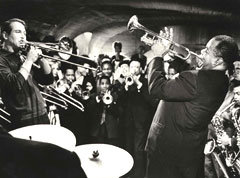Jazz Score
dal 15/4/2008 al 14/9/2008
Segnalato da
15/4/2008
Jazz Score
The Museum of Modern Art - MoMA, New York
Comprising a film retrospective, a gallery installation, live concerts, and a panel discussion, the initiative celebrates some of the best original jazz composed for the cinema from the 1950s to the present. It features a sampling of jazz-influenced merchandising, including a display of Polish and American film posters.

The introduction of contemporary jazz to film scoring in the mid-twentieth century brought fresh forms of sophistication and innovation to world cinema. Musicians like Duke Ellington, Miles Davis, John Lewis, and Quincy Jones joined Hollywood composers like Alex North, Elmer Bernstein, and Henry Mancini in exploring modern ways of accompanying both the light and serious moods of films.
The improvisational nature of jazz expression also suited the radical spirit of independent and New Wave filmmaking throughout the world. Even today, jazz music continues to have a dramatic impact on the visual design of film trailers and the graphics of film promotion.
This gallery exhibition, presented concurrently with an extensive series of films and live concerts, features a sampling of jazz-influenced merchandising, including a display of Polish and American film posters; video clips of jazz-scored scenes spanning five decades of international cinema; and a large-scale installation of original animation art from John and Faith Hubley’s Adventures of an * (1957)—a landmark short, newly restored by the Museum, featuring music by Benny Carter—and John Canemaker’s Bridgehampton (1998), featuring music by Fred Hersch. The animated works are also shown in full, both in the gallery and as part of the film series.
Organized by Ron Magliozzi, Assistant Curator, and Joshua Siegel, Assistant Curator, Department of Film.
The film retrospective opens on April 17 with a weeklong theatrical run of Arthur Penn's Mickey One, and continues with fiction features, experimental and animated shorts, and documentaries from countries as far ranging as France, Brazil, Japan, South Africa, and the U.S.
In 1951, Alex North's music for Elia Kazan's A Streetcar Named Desire opened up jazz scoring to a new generation of composers, including Elmer Bernstein, Duke Ellington, Bernard Herrmann, Quincy Jones, Henry Mancini, and Lalo Schifrin. Significantly, this jazz renaissance coincided with the breakup of the Hollywood studio system and the emergence of independent film directors, including John Cassavetes, Shirley Clarke, and Herbert Danska. These directors experimented not only with diverse film styles and techniques, but also with more improvisational forms of jazz like hard bop, modal jazz, and Afro-Cuban jazz. This was equally true of European and Japanese New Wave filmmakers in the 1950s and 1960s—Jean-Luc Godard, Louis Malle, Roman Polanski, and the American expatriate Joseph Losey among them—who enlisted such legendary artists as Gato Barbieri, Miles Davis, Dizzy Gillespie, John Lewis and the Modern Jazz Quartet, Thelonious Monk, Sonny Rollins, and Tôru Takemitsu. Jazz continues to be used in diverse ways in contemporary cinema, whether to evoke a writer's paranoid fantasies in David Cronenberg's Naked Lunch (1991; music by Howard Shore and Ornette Coleman) or the tragic devastation of the city that gave birth to jazz itself in Spike Lee's When the Levees Broke: A Requiem in Four Acts (2006; music by Terence Blanchard).
The exhibition is made possible by The Friends of Education of The Museum of Modern Art and by the Nicholas Martini Foundation. Additional support is provided by the Polish Cultural Institute, New York.
Titus Theater 1 Lobby Gallery, T1
Titus Theater 2 Lobby Gallery, T2
Upcoming related events:
Monday, May 19, 2008
7:30 p.m.
Concerts, Readings & Performances
The Tomasz Stanko Quartet with special guest Billy Harper: A Concert Tribute to Krzysztof Komeda
For press inquiries, please contact:
Meg Blackburn, 212/708-9757 or meg_blackburn@moma.org
THE MUSEUM OF MODERN ART MoMA
11 West 53 Street New York, NY 10019





